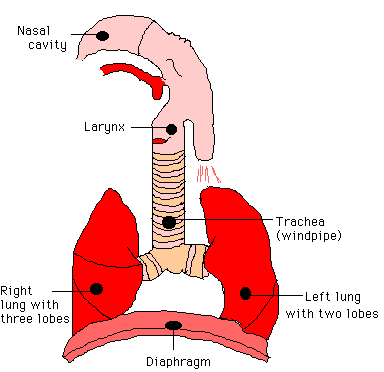
 |
Respiratory SystemSimilar to all mammals, primates have a constant body temperature, an efficient respiratory system featuring a separation between the nasal and mouth cavities, an efficient four-chambered heart that prevents mixing of oxygenated and deoxygenated blood, among other characteristics. Like humans and other land animals, Chimpanzees breathe out of nostrils in their noses and with the help of lungs. A pair of lungs are found in the airtight thoracic cavity that is bound by a convex muscular and elastic sheet called a diaphragm. When breathing normally through the nose, the air travels through the nasal passages that are lined with ciliated mucous epithelium. There are sensory cells that detect odors. As the air continues through the pharynx or the throat, it crosses the path of food. This is the reason why we can breathe through our mouth. Then, air passes the epiglottis, enters the voice box, also known as the larynx, and goes down the trachea or windpipe. Through each lung there are bronchioles that run through them, then divides in a tree like way to give smaller bronchioles and finally deposits the air in the microscopic thin walled air sacs or alveoli. A group of alveoli appear like a group of grapes and gives the lungs a sponge like structure. In each lung there are about 150 million alveoli. Altogether they cover a large surface area that is approximately 70 square meters. The blood that flows to the lungs by the pulmonary artery has little oxygen and a lot of carbon dioxide. On the other hand, the air in the alveoli has a high concentration of oxygen and less carbon dioxide. Thus a 2-way diffusion takes place through the cells of the capillaries. Oxygen enters the blood and CO2 leaves it. Since a lot of breathing surface of lungs is exposed to the outward environment the exchange of gases is computed within few seconds. |